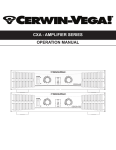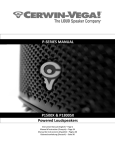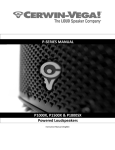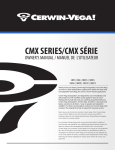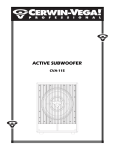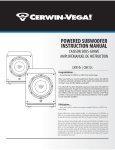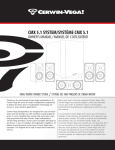Download Cerwin-Vega CXA-8 Specifications
Transcript
CXA Manual Rev 3_Manual_CXA_English_DB 1/31/2012 10:06 AM Page i CXA-8 & CXA-10 AMPLIFIERS OPERATION MANUAL CXA Manual Rev 3_Manual_CXA_English_DB 1/31/2012 10:06 AM Page ii WARNING CXA Manual Rev 3_Manual_CXA_English_DB 1/31/2012 10:06 AM Page 1 Cerwin-Vega! CXA-8 & CXA-10 AMPLIFIERS 1. INTRODUCTION 2. UNPACKING & INSTALLATION 3. ABOUT THE CERWIN-VEGA! CXA-8 & CXA-10 AMPLIFIERS Congratulations! Welcome to the Cerwin-Vega! family. You’ve joined a growing group of audio professionals who have turned to Cerwin-Vega! for the most advanced audio reproduction systems available. All Cerwin-Vega! systems are thoroughly tested to insure that they meet or exceed our performance specifications. Backed by the best service in the industry, Cerwin-Vega! is dedicated to quality and reliability. For a complete overview of Cerwin-Vega! products, accessories, and services, log onto www.cerwin-vega.com. Although it is neither complicated to install, nor difficult to operate your amplifier, a few minutes of your time are required to read this manual for a properly wired installation, and to become familiar with the unit’s features. Please take great care in unpacking the unit and do not discard the carton and other packing materials. They may be needed when moving the unit and are required if it ever becomes necessary to return the unit for service. Never place the unit near a radiator, in front of heating vents, in direct sunlight, in excessive humidity, or dusty locations to avoid damages and to guaranty a long reliable use. Connect the unit with the system components according to the description on the following pages. The Cerwin-Vega! CXA-8 & CXA-10 high performance stereo and bridgeable power amplifiers are for those that want to sound like a pro! These home-use versions of the renowned Cerwin-Vega! Professional series amplifiers. The same capability for shock and awe, but with input/output connections and a form factor suited for performing at home versus on stage. These workhorses have the muscle to accommodate the most demanding audio challenges. With power ratings of up to 1800 watts* (for the CXA-8) and 2800 watts* (for the CXA-10), exceptional THD (Total Harmonic Distortion) and Signal-toNoise ratings, the CV Series power amps are the right choice for a wide range of music and home theater applications. To ensure reliable operation the CXA amps include a highly efficient variable speed tunnel cooling system that dynamically follows amplifier output levels. The 21-position detent level control knobs help you set and maintain volume settings. Signal and clip indicators provide a convenient way to monitor the amplifier’s status. Proven professionally -- the CXA-8 & CXA-10 Amps are right for the job – even when the “job” is entertaining friends and family. Main Features: • Power ratings up to 2800 watts – run in stereo or bridged • Professional quality design and reliability • Flow-through cooling design prevents overheating • Defeatable limiter and high pass filter per channel • Detented 21-position input level control knobs • Front panel LED indication of power, clip protect and signal status 1 CXA Manual Rev 3_Manual_CXA_English_DB 1/31/2012 10:06 AM Page 2 Cerwin-Vega! CXA-8 & CXA-10 AMPLIFIERS CXA AMPLIFIER FRONT PANEL DESCRIPTION Figure 1.1 1. Fan Vent The CXA-8 & CXA-10 amplifiers are cooled by two rear-mounted fans. Cool air flows through the front fan filters, reducing the temperature of internal components while forcing the heat out the rear vents. Never block these vents and keep them clean at all times. 5. Active Indicators These blue LED's indicate that AC power is connected and the amplifier is turned on. 6. Protect Indicators These red LED's indicate that the channel is in Protect mode. When the channel goes into protect mode all output for that channel will be muted. The protect LED's light when overheating or other severe problems occur. This is to protect any speakers connected to the channel. The LED's also light for approximately five seconds whenever the unit is powered on and fade slowly when the amplifier is powered off. 2. AC Power Switch This switch powers the unit on and off. 3. Signal Indicators These blue LED's will illuminate to indicate that a signal is present at the amplifier input, and that the signal is being amplified. 7. Channel input level control These two 21-position detented potentiometers adjust input level for their respective amplifier channels. In Bridged Mono Mode, only channel 1 level control is used to adjust signal level. In Parallel Mode, both input level control are used to adjust signal level for their respective amplifier channels. At their fully counter-clockwise position, the signal is attenuated by more than 80dB. At their fully clockwise position, the signal is at maximum gain.When 0 dBu of signal arrives at the input jacks and the Channel input level controls are set to their fully clockwise position, the unit delivers full power output. 4. Clip Indicators These red LED's will illuminate at the clipping threshold. These lights should not light up during normal use as they indicate signal outside of the amplification range of the amplifier. When a signal is "clipped" and the clip indicator illuminates, it means that the signal is being distorted at the output stage. Prolonged clipping can not only damage your amplifier, but also your speakers, so be careful to monitor the clip indicator during setup and use. If the clip indicator is illuminated then simply lower the channel gain or input signal until the indicator does not light. 2 CXA Manual Rev 3_Manual_CXA_English_DB 1/31/2012 10:06 AM Page 3 Cerwin-Vega! CXA-8 & CXA-10 AMPLIFIERS CXA AMPLIFIER REAR PANEL DESCRIPTION Figure 1.2 1. Fan This is a variable speed cooling fan. Cool air enters the amplifier through the fan filters located on the front of the amplifier. Be sure not to block these ports when installing the amplifier or other equipment. 2. Input connectors Connect the input source to the unbalanced RCA connectors using standard RCA cables. 3. Link connectors These jacks are used to send a parallel signal to another device or amplifier. 4. High Pass Filter (HPF) switch. These switches are used to activate the built-in High Pass Filter. The HPF rolls off signals below 40Hz. This improves bass performance by limiting sub-audio cone motion, making more power available for the speaker’s rated frequency range. When the filter is turned off, a 5 Hz roll off protects against DC or deep sub-audio inputs. 5. Limiter switch When the input signal connected to your amplifier is too high, you end up with a distorted output signal. To prevent this, both channels feature a clip limiter that can be engaged or disengaged selectively. 3 6. Bridge / Stereo / Parallel switch This switch changes the amplifier operating mode between stereo, mono bridged, and parallel. 7. 5-way Binding Post Connect each channel of the unit to your speakers. Binding posts are provided for each channel as so that paralleling of speakers is possible. Connection to the binding posts can be made with bare wire, banana plugs, or spade lug terminations. Make connections to both the Channel 1 and Channel 2 terminals for Stereo or Parallel Mode, or a single connection across the red terminals only of Channel 1 and Channel 2 for Bridged Mono Mode. 8. Circuit breaker The breaker acts in place of common disposable fuses. This circuit breaker will trip if there is a fault with the main voltage or if maximum output is exceeded. Simply depress the circuit breaker and power up the unit again. 9. AC input IEC connector for AC power cable. Connect the supplied heavygauge 3-pin IEC power cable. CXA Manual Rev 3_Manual_CXA_English_DB 1/31/2012 10:06 AM Page 4 PROTECTION Every model in the CXA-Series incorporates protection features. The front panel Protection LED indicates the activity of the speaker connection relay circuitry in each channel.When the protection LED turns on, this circuitry is active, and all connected speakers are muted. Initial power-up : For approximately five seconds after initial power-up, the protection circuitry is activated and the speaker outputs are muted. If everything is operating normally, you will hear an audible click at the conclusion of this brief period, as the protection circuitry is deactivated and the unit begins delivering signal to the connected speakers. It is normal for the Protection LED to fade gradually after the amplifier is powered off. Thermal Protection : Abnormally high heat sink temperatures will engage the protection circuitry for the overheating channel only. An output relay disconnects the speakers until normal temperature range is restored. The Protect indicator will light to show the protection circuit is active. To guard against this problem, make sure the unit receives adequate ventilation on all sides and that both the front and rear panels are unobstructed. If the power transformer gets too hot, its thermal switch will disconnect all of the secondary power and disconnect both channel outputs. Short circuit : If output is shorted due to faulty wiring, the thermal circuitry will automatically protect the amplifier. If this occurs, the load will be disconnected by the thermal protection circuitry. DC Voltage Protection : If an amplifier channel detects DC voltage at the speaker output, the output relay will immediately open to prevent speaker damage. Subsonic Frequency Protection : The built-in High Pass Filter provides subsonic frequency protection for each channel. Current limiting Protection : At the amplifier’s full power limit, or clipping point, the limiter circuitry will be activated. This is indicated by illumination of the Clip LED. The channel gain is automatically reduced, protecting the speakers from high power. Uncontrolled feedback, oscillations, or improper equipment gain setting may activate this circuitry, which is virtually transparent in operation as full signal bandwidth is maintained. There is reason to be concerned any time the Protection LED lights up (except for initial power-up during approximately five seconds). If this occurs, turn the amplifier off immediately and SETUP Clip limiter HPF (Hi-Pass Filter) Limiter Clipping is the result of an amplifier running into power supply limitation. The maximum output voltage that any amplifier can produce is limited by its power supply. Attempting to output a voltage (or current) level that exceeds the power supply limit will result in a flattening effect on the signal. A clipped waveform exhibits extreme harmonic distortion, making it sound harsh or dissonant. The clip limiter detects this and reduces the gain to minimize the amount of overdrive. To preserve as much of the program dynamics as possible, limiting reduces the average program level until peaks barely clip. Each channel has its own clip limiter, which can be switched on or off. When driving fullrange speakers, clip limiting reduces high frequency distortion caused by bass overload. It also protects higher frequency drivers from excess overdrive and harsh clipping harmonics. Also known as a low-cut filter, a High Pass Filter rolls off signals below 40Hz. The reproduction of the signal’s bass portion is thus optimized, since ultra-low, distracting frequencies are eliminated, and more power is available for the reproduction of the wanted segment of the signal. You should set up the filters so they best suit the frequency response of your speakers, since some speakers are particularly sensitive to over-excursion. The 40Hz filter works well with most compact full-range speakers. 4 CXA Manual Rev 3_Manual_CXA_English_DB 1/31/2012 10:06 AM Page 5 SETUP (CONTINUED) CONNECTIONS Mode Select Stereo Mode (5-Way Ouptut Binding Posts) Stereo Mode In stereo mode, both channels operate independently with individual input gain controls. Signal at channel 1’s input produces output at channel 1, while signal at channel 2’s input produces output at channel 2’s output. Recommended minimum nominal load impedance for stereo operation is 2 ohms per channel. Parallel Mode Parallel Mode When set to Parallel mode, a signal applied to channel 1’s input will be amplified and appear at outputs for both channel 1 & 2. The parallel mode is well suited for applications in which driving two speakers with the same signal but with separate amplification. The ‘Channel1’ and ‘Channel 2’ input gain controls individually control the out put level on channels 1 and 2. (5-Way Output Binding Posts) Bridged Mono Mode Bridged mono mode straps both amplifier channels together to make a very powerful, single-channel monaural amplifier. One channel ”pushes” and the other channel “pulls” equally, doubling the power over that of either channel alone. Therefore the voltage is doubled, the peak power is quadrupled, and program power is roughly three times as high as that of the individual channel. Signal is applied to the channel 1 input only and channel 1 input gain control is used to adjust signal level. The input gain control belonging to channel 2 are not used. Bridged Mono Mode Note : Bridged mono mode is to be used only when the CXA-Series is connected to a 4 or 8 ohms speaker load. Use of Bridged mode with speaker loads of less than 4 ohms can result in severe damage to the unit due to excessive heat and current limiting. Use extreme caution when operating the amplifier in Bridged Mono Mode. Never ground either side of the speaker cable; the speaker load must “ float “ away from the amplifier chassis. 5 (5-Way Output Binding Posts) CXA Manual Rev 3_Manual_CXA_English_DB 1/31/2012 10:06 AM Page 6 Cerwin-Vega! CXA-8 & CXA-10 AMPLIFIER SPECIFICATIONS CXA-8 CXA-10 Stereo Both Channels Driven Output Power (RMS) 8 ohms 400 W 600 W 4 ohms 600 W 900 W 2 ohms 900 W 1400 W Output Power (RMS) Bridged Mono 8 ohms 1200 W 1800 W 4 ohms 1800 W 2800 W Signal to Noise Ratio (20 Hz - 20k Hz) 102 dB 104 dB Distortion (SMPTE-IM) 0.01% 0.04% Input Sensitivity @ 8 ohms 4 dBu 4 dBu Voltage Gain 33 dB 35 dB Output Circuitry Class AB Class H Current Consumption 120V / 230V @ 1/8 power @ 4 ohms 8.8 / 4.4 amps 6.8 / 3.4 amps @ 1/3 power @ 4 ohms 12 / 6 amps 17 / 8.3 amps @ Full power @ 4 ohms 19.5 / 9.5 amps 32 / 16 amps 20 Hz - 20k Hz @ 1/2 Power 0.01% 0.03% 1k Hz @ Full Power 0.10% 0.10% Distortion FREQUENCY RESPONSE +/- 0.5 dB 20 Hz - 20 kHz +/- 3 dB 5 Hz - 60 kHz Damping Factor (400 Hz) 280 350 Input Impedance 15k ohm Un-balanced / 30k ohm balanced Input Clipping 22 dBu (10 Vrms) Continuously variable speed fan, front to rear Cooling CONNECTORS Input Unbalanced RCA input and link out Output 5-way binding post CONTROLS Front AC power switch / Channel 1 & 2 volume Rear HPF Switch / Limiter Switch / Mode Selector Switch Indicators Power On: Light Blue / Signal: Dark Blue / Limit-Clip: Red Protection Short Circuit / Thermal / Current Limit resetable breaker / DC offset / Current In-Rush / RF Protection / On-Off Mute Power Requirements 120V 60Hz (USA) / 230V 50Hz (EU) Dimensions Net Weight 482 X 101 X 420 mm 18 Kg 6 18.8 Kg CXA Manual Rev 3_Manual_CXA_English_DB 1/31/2012 10:06 AM Page 7 Cerwin-Vega! A member of the Gibson family of brands Gibson Customer Service • 309 Plus Park Blvd. • Nashville, TN 37218 Phone: 1-800-4GIBSON (1-800-444-2766) E-mail: [email protected] www.cerwin-vega.com LITH00023 CXA OWNERS MANUAL © 2012 CERWIN-VEGA ALL RIGHTS RESERVED This document is copyright protected. No part of this manual may be copied or reproduced in any form without prior written consent from CERWINVEGA. CERWIN-VEGA shall not be liable for operational, technical, or editorial errors/omissions made in this document.









